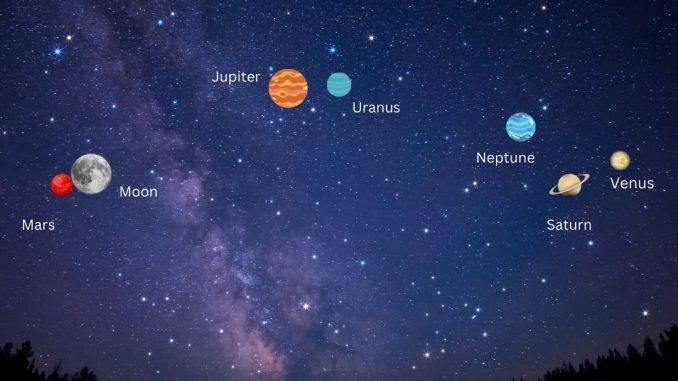
Throughout the month of January, the planets Venus, Mars, Jupiter and Saturn will be naked-eye visible at the same time in the night sky. Neptune and Uranus are also on the scene, but observers will need optical aids to view them. The planets appear to be in a line in the sky, but this is because all of them orbit along the same plane around the sun, known as the ecliptic. Mercury will also enter the picture for a few days starting on Jan. 25, meaning all seven orbs will share the sky briefly around sunset.
Multiple planets are often visible together in the night sky. What makes this moment unusual is the number of planets that will observable at the same time. “It doesn’t happen that often that you’ve got so many planets visible in the night sky, but it does happen,” said Alan Cousins, vice president of the Custer Institute and Observatory in Southold. “It’s how it plays out with the different orbits and the different rates that the planets go around the sun, relative to each other and to Earth. So it’s certainly a wonderful opportunity this month.”
It’s a bit overblown to call this an “alignment” as the planets will not be stacked neatly one behind the other on one side of the sun. A more appropriate term in use by NASA is a “parade of planets.” Still, from an observational standpoint, this is a good opportunity to see multiple planets on a single evening. “For casual stargazers on their own, they’ll be able to see Venus and Saturn, Jupiter and Mars naked eye throughout the evening. Also, if they know where to look, they can find Uranus and Neptune with binoculars or a telescope,” Mr. Cousins said.
Depending on the cloud cover, colder conditions sometimes make for clearer stargazing. “We’re looking through many tens of miles of atmosphere, and even if it is cold and crisp, it depends on the movement of different layers,” Mr. Cousins explained. “Our atmosphere may not always be a perfectly stable sky. So even though it looks crisp, if the stars are twinkling, that probably tells us the atmosphere is a little bit unstable. It may not be the best viewing — but again, it’ll it all depends on any given night.”
Later this year, the sun will reach its solar maximum — the most active phase of the 11-year solar cycle — which could lead to more intense auroras like the ones observed in our area last fall. “The events can’t be predicted. Certainly, as solar activity increases, [so does] the potential for a notable solar flare with the resulting aurora,” Mr. Cousins said. “Since we’re reaching the solar maximum, the potential is there, but it’s not predictable.”
If you’re still expecting the planets to truly align, you may be in for a disappointment: According to EarthSky.org, the eight planets only line up within 3.6 degrees of sky every 396 billion years. The sun is currently about 4.6 billion years old and is predicted to turn into a red giant some 5 to 6 billion years from now, swallowing up the inner planets — including our own — in the process.

